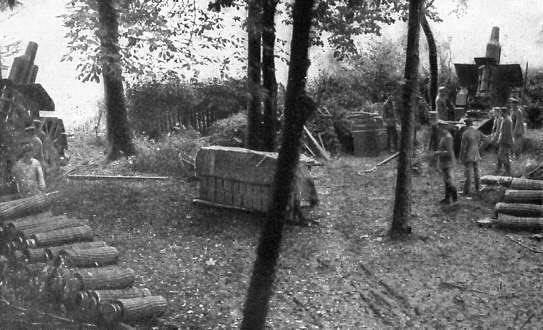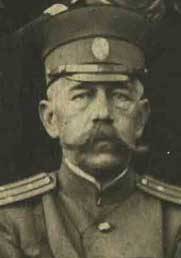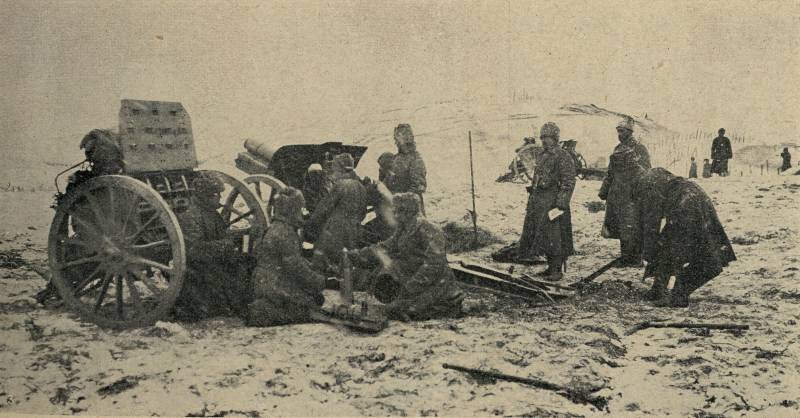Artillery density of the First World
Allied experience.
In September, during the operation in Champagne, the French concentrated on the 1915-km front for artillery preparation of 35 1100-mm light field guns and 75 heavy guns. Thus, on the 872 km of the front accounted for up to 1 guns. Artillery preparation lasted 57 day. During this time, 3 light and 1387370 heavy shells were fired - which accounted for 295800 projectiles per meter of front.
In the summer of 1916, during the preparation of the Somme breakthrough, the French conducted artillery preparation for 7 days, concentrating on the 15-km front of the 1449 guns, of which 645 are heavy. In this operation, density was achieved in 100 guns on 1 km of front. The consumption of shells surpassed all previous standards. From 24 June to 10 July, 2532649 shells were fired, of which only on the day of the attack (July 1) - 380000. In total, 166 shells per meter of front (26 shells per meter per day of attack) were expended during this operation.
But, despite such a rich front, the French still came to the conclusion that they ... did not have enough artillery for success.
Therefore, in April 1917 in the battle on the river. Enna they focus on 40-km front 5597 guns or near 140 guns on 1 km front. Artillery preparation was supposed to last 5 days (in fact, it lasted 8 days).
In the rest of the operations “with limited targets” 1917, the French had: on Ypres (July 31) 153 guns and near Verdun (August 20 26) 157 guns on the 1 km of the front. Artillery training continued: on Ypres 16 days, under Verdun 7 days.
Finally, in the last similar operation of 1917 of the year - in October, near La Malmaison, the French had 160 guns on 1 km of front, and the artillery preparation, which lasted 6 days, leveled off most of the enemy fortifications. After such training, the French managed to advance a little more than 4 km on the 10 day of the fighting on the 6-km front. Moreover, General F. Err described this operation as follows: "This brilliant victory remained a model of the offensive with a limited goal."
But who will now call a “brilliant victory” an operation in which troops advance at a speed of 1500 meters per day, while having 160 guns per kilometer of the front?
Under the Malmaison, the French spent 6 tons of shells for 68500 days of artillery preparation - more than 6 tons per meter of front (for comparison - at Somme in 1916 about 1 tons per meter).
1918 was a turning point for massaging artillery and the consumption of shells. Having reached 160 guns per kilometer and 6 tons of shells per meter of front, the allied artillery densities in 1918 show a significant decrease in these indicators. The French took into account the experience of German offensive operations in the first half of 1918. In addition, the possibility of mass application appeared tanks.
In July - August 1918, for an offensive in the Chateau-Thierry-Soissons area, the French concentrated on an 18-km front 40 aviation squadrons, 375 tanks and 1620 guns (90 guns per 1 km of the front). Artillery preparation in the main direction was not carried out, and in the secondary direction it lasted only an hour and a half.
In subsequent operations, the French had: near Amiens 45 guns on 1 km, between the RR. Oise and En - about 104 guns on 1 km, in the battle between Reims and Argonnes (September — October) - about 102 guns on 1 km front.
Thus, by the end of the war, the French returned to the norms of the 1916 of the year and finally abandoned their multi-day artillery preparation, limiting its duration to hours, and in some cases not practicing it at all.

French battery during the attack in Champagne.
Germanic density.
Already in the first half of the war, the Germans took into account the negative consequences of multi-day artillery preparation and did not even attempt to impose on artillery the task of completely eliminating the enemy’s defensive line. They limited themselves to short artillery preparation, measured by hours, which was supposed to temporarily neutralize the enemy’s main combat resources at the front line.
In operations on the Russian front, the artillery preparation of which was led by the famous artillery authority G. Bruchmüller, the Germans usually conducted 4 - 6-hour artillery preparation.

Col. G. Bruchmüller.
So, for example, in November 1916, when the Germans broke through Vitonezh, had 80 guns on the 1 km of front. The artillery preparation lasted 5 hours 15 minutes. When attacking a bridgehead at the village. Tobolye, the Germans had up to 50 guns and mortars on the 1 km front - with artillery preparation of 5 hours 45 minutes.
In 1917, at the breakthrough on r. Ceret (Eastern Galicia) Germans concentrated 138 batteries (552 guns) plus 176 medium and heavy mortars on the 8-km front - which amounted to 90 guns and mortars per kilometer of the front. The artillery preparation continued for 5 hours. In August of the same year, during the Riga operation, the Germans had about 95 guns and mortars on the 1 km of the front. The duration of the artillery training is also about 5 hours.
It is interesting to note that the Bruchmüller experience was moved by the Germans from the Eastern Front to the Western - and in the spring of 1918 in France brought brilliant results. At the same time, the Germans went on further reducing the duration of artillery preparation, limiting its 27 on May 2 to 40 hours by minutes, and concentrating 1100 batteries on the 38-km front - that is, about 30 batteries (120 guns) on the 1 km front.

Germanic 210-mm howitzers on the position.
Artillery density of the Russian army.
What kind of artillery density used by the Russian army?
In the Battle of Galicia 1914, the artillery densities were 6 - 7 guns per kilometer of the front. And with such miserable densities, Russian troops captured up to 100 thousands of prisoners and 400 guns, advancing on 85-240 (for different armies) kilometers.
In the course of the Brusilovsky 1916 breakout, the artillery densities for the 8 Army amounted to only 20 guns per kilometer of the front. The flagship of the front was the 9-I army - with the breakthrough of the Austrian position at der. Dobronouc in the area of the main attack of the 11 Army Corps on the 3,5-km front was concentrated 159 guns - 45 guns on 1 km front. The duration of the artillery preparation is 5 hours 15 minutes. In this operation, the actions of the artillery were led by a well-known specialist, the “Russian Bruchmuller,” Colonel V.F. Kirey.

Col. V.F. Kirei.
And with such densities - what is the result!
. Capturing the 408 thousand prisoners, 581 weapon, 1795 guns, 448 mortars and mortars of the enemy, but in the first 13 days of the onset of South-Western Front advanced 8-th army - on 75 km and 9-th army - on 50 - 60 km the depth. Moreover, the Austro-German troops were shot down from their long-echelled positions on the front 200-kilometer length.
The operation became one of the most successful offensive operations in the domestic military stories. And the Russian army showed high combat effectiveness at low artillery densities.

Russian howitzer battery in battle.
Information